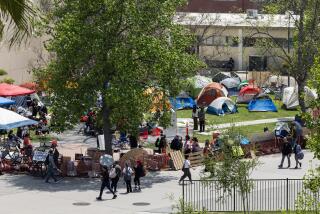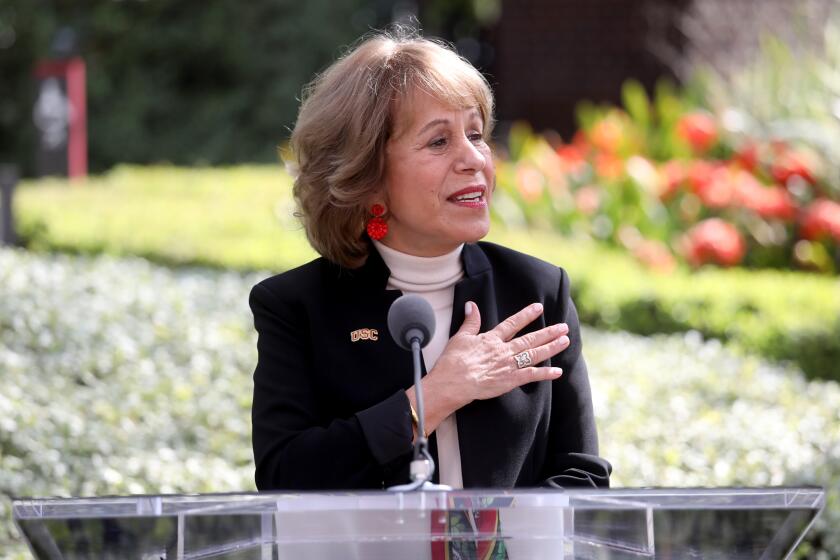USC Helps Staff Buy in Community
Even one year later, Ken and Billie Wallace still marvel that they can practically reach out and touch Los Angeles’ downtown skyline and watch Dodger Stadium fireworks from their Boyle Heights home, a purchase made through a special USC homeownership program.
Established in 1995 by USC President Steven Sample as part of a broad effort to strengthen ties within the communities surrounding the university, USC’s Neighborhood Homeownership Program so far has helped 77 qualified employees, including the Wallaces, make monthly mortgage payments, replace outdated plumbing, build fences and landscape properties situated within walking distance of the school’s two urban campuses.
Currently, about 6% of the USC University Park faculty and staff live within the two ZIP Codes encompassing that campus.
Under the guidelines of the Neighborhood Homeownership Program, qualified participants--faculty and staff who work at least half time and own and occupy homes near campus--receive $25,000, paid in increments over seven years, according to program administrator Maxine McNeal.
The participants must show proof of homeownership first, and must remain in good standing with the lenders throughout the life of the contract. If they move out of the home or sell it, the payments stop.
“Twenty-five thousand dollars doesn’t sound like a lot of money, but it can make the difference of whether people are lifetime renters or property owners,” Sample said. “The program benefits us at the university too because property owners make the best neighbors. We also have tremendous stability in our workforce here.”
In the Wallaces’, case, the promise of funding actually helped them get a bigger and better house than they had hoped for.
Ken Wallace, 56, a longtime public safety employee at the school’s health science campus, and his wife, Billie, 57, a South Pasadena Police Department employee, did not believe they could qualify for a home, so they never tried. After hearing about the program, however, the couple was spurred to get a home loan and then qualified for the university stipend, which helps pay the mortgage.
The three-bedroom house, which cost about $120,000, is the couple’s first.
“Getting that money shoved me into homeownership,” Ken Wallace said. “It has given me a sense of self-worth, to feel that I’ve arrived.”
Patty and Ralph Cardenas were among the first to enroll in the homeownership program, nearly seven years ago. The couple, who had one baby at the time (they now are parents of three children), originally had not planned to look for a home near the university’s health science campus.
But after finding their $160,000, three-bedroom home in Hillside Village, across the street from an elementary school, the pair joined the program, which allowed them to buy a bigger house than they could have afforded otherwise, said Patty Cardenas, an 11-year USC employee.
Universities across Southern California increasingly are having to find incentives to attract faculty and staff to a region where median home prices today run from $258,000 in Los Angeles County to a staggering $346,000 in Orange County, according to DataQuick Information Services, which tracks home prices and sales across the state.
UC Irvine offers luxury homes for affordable prices in the school’s University Hills, a faculty-only community where one can qualify for special low-interest loans backed by the university.
Several Cal State campuses also are buying up land on which they will build affordable homes for faculty, a strategy that is paying off in attracting sought-after professors.
The USC program, in addition to helping staff members achieve homeownership, boasts some success in bringing faculty and staff to neighborhoods whose residents historically have viewed the university as an island of wealth that often ignored its neighbors.
Sociology professor Leland Saito, 46, a first-time buyer and recent participant in the USC homeownership program, jumped at the opportunity to join the university community and is thrilled to live minutes from campus after years of apartment living at his previous teaching post in San Diego.
Saito is studying the economic revitalization of downtown Los Angeles and said he now will get first-hand experience of neighborhoods undergoing demographic changes and economic transformation. As an added bonus, he rides his bicycle to campus from his three-bedroom, Spanish-style house, a convenience he never imagined enjoying. “This gives me a chance to be a part of the campus life here,” Saito said.
Close proximity to campus and downtown cultural events propelled physics professor Tu-Nan Chang, 57, and his wife Hsiao-Lin Chang, a Cedars-Sinai Medical Center biologist, to their University Park townhouse four years ago.
After commuting to campus from West Covina for about 23 years, Tu-Nan Chang now leases from the university the land on which his townhouse sits and owns the townhouse itself.
“I was sick and tired of all that traffic,” said Chang, who served on the original committee that established USC’s outreach programs. “We wanted to improve the neighborhood, to get community members involved with the university, rather than have them view us as outsiders.”
The only downside to USC’s neighborhood improvement plan, according to those involved, is the impact on renters, especially university students, who now are facing higher rents as property values have increased in some areas around the campus.
But most of the residents in the area are happy to see their homes appreciate in value, said Carolyn Cohen, 33, who with her husband, Steve, 40, bought their home near the University Park campus a year and a half ago.
The couple, both of whom work for the university, flipped when they saw the 103-year-old, 3,000-square-foot Craftsman house just blocks from the campus. After searching for months for an appropriate home for themselves and their numerous pets, they jumped at the chance to fix up the house that features three bedrooms, an entertainment room, two offices and a breakfast room, all for $260,000.
“I love this house,” said Carolyn Cohen, who is using the USC funds to help with the mortgage and to refurbish the house. “I feel more a part of the community.... It’s been a real positive experience.”
More to Read
Start your day right
Sign up for Essential California for news, features and recommendations from the L.A. Times and beyond in your inbox six days a week.
You may occasionally receive promotional content from the Los Angeles Times.






